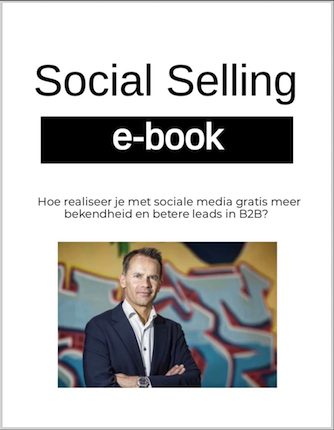21 tips to boost your Social Selling Index (SSI)
LinkedIn is the go to social platform in B2B. With the ever increasing scale of this network the probability goes up to drown in the countless updates on your LinkedIn timeline. How do you ensure to use LinkedIn effectively? The Social Selling Index offers help.
Social Selling Index: barometer for success
The Social Selling Index (SSI) helps you to assess how effective your use of LinkedIn as social selling platform is. LinkedIn follows the activities and progress of its users on a daily basis. You might think that is a little scary. Equally it offers a great, daily opportunity to gauge if your SSI has improved, and in what aspect.
What is Social Selling?
Some people think Social Selling is just something for salespeople like accountmanagers and commercieel directors. Others claim Social Selling is nothing new.They consider social media as the new opportunity to sell their products in an old fashioned, ‘push’ manner to customers. That attitude has as little to do with Social Selling as Formula 1 champion Max Verstappen has in common with an opera diva.
So what is Social Selling all about?
Social Selling is the smart use of sociale media like LinkedIn or twitter for commercial purposes. By better responding to questions and updates by customers and prospects alike, you are building authority, awareness and trust. That in turn produces an increased probability of leads, opportunities and business.
Social Selling Index: 4 goals
The SSI differentiates these 4 goals:
- Establish your professional brand
- Find the right people
- Engage with insights
- Build relationships
A) Establish your professional brand
Branding is no longer the exclusive domain of hip advertising agencies or enterprise companies in FMCG like Unilever or Mars. Every professional has his (or her) own identity and brand. The corporate branding increasingly is the sum of all individual brands added together.
A mistake often made is to think that this only applies to celebrities, best-selling authors or other VIPs. By a clear positioning building a professional brand is possible for both people in sales like accountmanagers or commercial directors and non salespeople. Think for instance of aan adviseurs in de zakelijke dienstverlening waaronder accountants, belastingadviseurs en management consultants.
B) Find the right people
Building a strong network is more than just expanding a virtual cabinet of business cards. By establishing a virtual connection with the right people you are building a close, business network.
Think of relevant connections with existing customers or prospects. Often it is super valuable to get in touch with alumni and colleagues at your current and previous employers.
Reaching out to someone outside your current network may feel akward. By an introduction via a common connection however, you can easily overcome that threshold. Furthermore, it often is easier to get in touch with influencers like Menno Lanting, Jim Stolze, Guy Kawasaki or Gary Vaynerchuck than you may think.
C) Engage with insights
Social media are a gigantic, virtual 24/7 pub. In that cafe the latest gossip and news are being exchanged, and stories are told. Those can be success stories yet complaints too. They may in fact be about your product or company. It is therefore essential to monitor such signals properly and timely.
Market developments and new market trends can be properly monitored via social media. Frequently asked questions can be found easier via twitter or LinkedIn.
Market research too can be executed via social media. Firstly it is possible to measure what update or piece of content (think of an e-book or whitepaper) performs best. You can also launch a mini-poll or survey via twitter or LinkedIn: super smart!
D) Build relationships
Merely adding cold contacts to your network does not work. Think of your family for instance. You also do send your brother or mother a postcard or email, don’t you? Or you would invite them to go to the theatre or recommend them that fine series on Netflix.
Your business network is not fundamentally different. By the occasional update from your end you strengthen the ties in your network. That is most effective when your update or post is truly relevant for the recipient. It is not so much about you as the sender but about him or her as recipient. Therefore always check ‘What’s in it for me’ before sharing your update, post or direct message.
Check these 21 activities in Social Selling
Below you see a randomly ordered list of 21 activities that can improve your Social Selling Index. LinkedIn can assess and measure almost all of these aspects. All other examples (eg sending an old fashioned message in the mail) indirectly benefit your network and SSI too.
First of all: set your ambition as to what you want to achieve by means of LinkedIn.
Is is to strengthen your personal brand, or would you like to expand your network by finding relevant, new contacts? Perhaps you would like to better maintain contact with the people within your existing network? Or is your ambition primarily to find better insights and content and exchange these in your network?
The below 21 examples each fit into one of the four Social Selling Index categories.
It is essential to determine a specific SSI objective. Is it establishing your professional brand, finding the right people, engaging with insights or building relationships?
Take the Social Selling quiz now
The below 21 examples each pertain to a specific category that makes up your personal Social Selling Index.
Each activity belongs to a specific ambition in the SSI. Per activity, determine which of these 4 ambitions that is:
- Establishing your professional brand
- Finding the right people
- Exchanging information
- Building relationships
1. Establish contact with various decision makers
The proper answer is D: build relationships. That’s clear, right?
2. Publish updates with your own opinion
The proper answer is A: establish a professioneel brand. Do yo copy?
3. Build new contacts via a warm introduction
The proper answer is B: find the right people. That one is kind of obvious, isn’t it?
4. Ensure information is customised for the recipient
The proper answer is C: exchanging insights.
5. Research prospects via a common denominator or LinkedIn groups
The proper answer is B: find the right people.
6. Share news
The proper answer is C: exchanging insights and information.
7. Look for new contacts: 2nd or 3rd degree
The proper answer is B: finding the right people.
8. Update your profile with the ideal customer in mind
The proper answer is A: establish a professional brand.
9. Follow relevant news about your industry or profession
The proper answer is C: engage with insights and information.
10. Build a network within your own company too
The proper answer is D: building relationships.
11. Providing answers to updates
The proper answer is A: establishing a professional brand.
12. Include skills in one’s profile
The proper answer is A: establishing a professional brand.
13. Maintain contact with influencers
The proper answer is D: build relationships.
14. Commenting (eg updates)
The proper answer is C: engaging with insights and exchanging information.
15. Send your network the occasional update or tip
The proper answer is D: build relationships.
16. Participating in LinkedIn groepen
The proper answer is C: engaging with insights and sharing information.
17. Include endorsements in profile
The proper answer is A: establish a professional brand.
18. Find the influencers: who are the nodes in your network?
The proper answer is B: find the right people.
19. Send the occasional letter or DM/direct mail
In this case, the proper answer is D: building relationships. You got that one right, didn’t you?!
20. Inbound leads: who looked at your profile?
The proper answer is B: finding the right people.
21. Writing a blogpost
The proper answer is A: establish a professional brand.
All the best in improving your Social Selling Index (and way more importantly: your business objectives)!
Do you want to get more commercial impact from social media in B2B?








